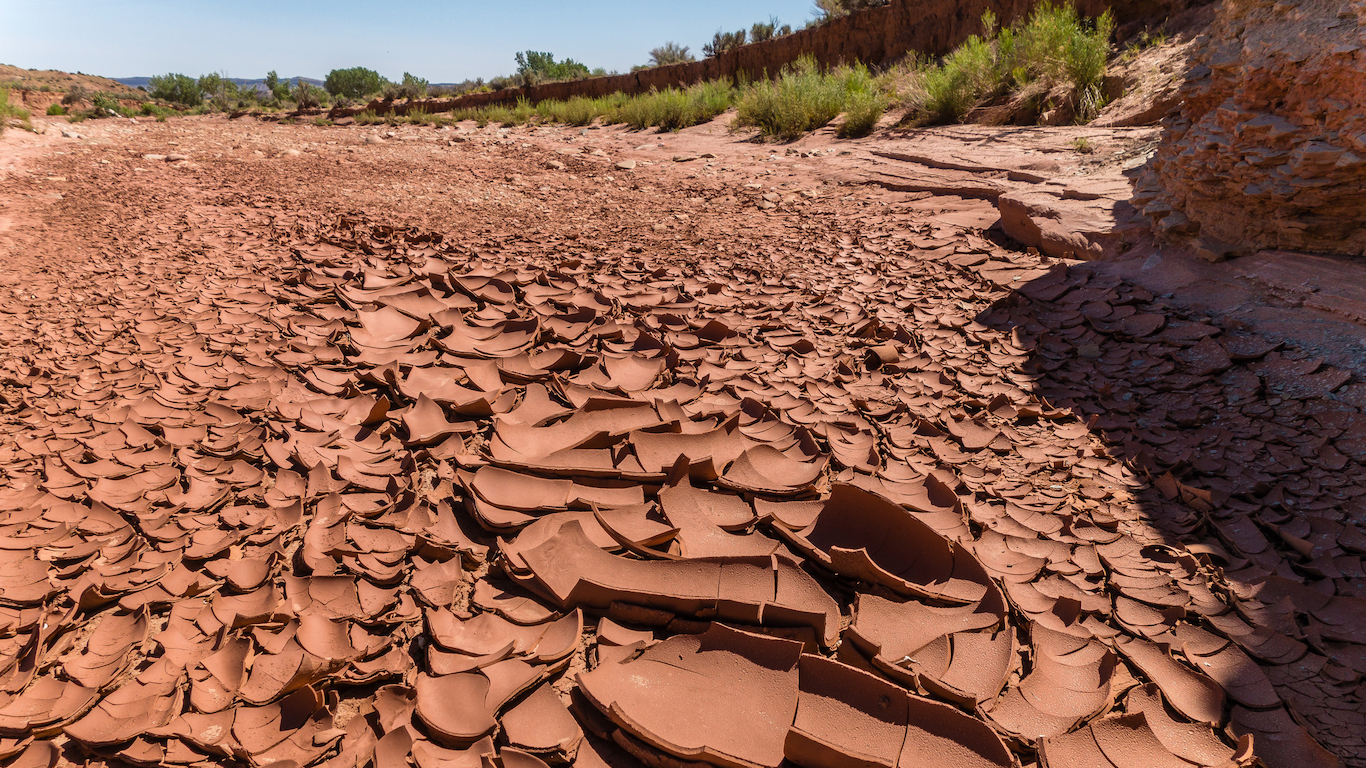
The average surface temperature in the United States has increased by 1.3 degrees to 1.9 degrees Fahrenheit since 1895, with a majority of the increase occurring in the last 50 years.
In addition to its more observable effects on everyday life such as rising temperatures, increases in extreme weather events, water shortages, and wildlife destruction, the climate crisis is contributing to reductions in the size and flow of America’s mightiest rivers. If steps are not taken to mitigate the emergency, these effects will continue to escalate.
In addition to climate change, the overallocation of water resources, mismanagement of water diversion projects, and increased water demand due to population increases are putting America’s most important rivers at risk of flow reduction. Already there are long-term signs some of America’s most iconic rivers, such as the Rio Grande and Colorado, are drying up and may soon join the growing list of attractions that are being destroyed by climate change.
To determine the U.S. rivers that are running dry, 24/7 Wall St. constructed an index based on data related to major U.S. river corridors. We considered the time a corridor was in severe drought and the percentage of land classified as being in severe drought over the past year. We also considered the change in annual temperature and annual precipitation over the last 50 years. Only rivers greater than or equal to 250 miles in length were considered.
Correction: A previous version of this article incorrectly characterized advocacy group American Rivers’ position as supportive of a proposed diversion project. In fact, the group argues the project must be stopped to save the river. This has been corrected.
Click here to see the full list of U.S. rivers running dry
Click here to read our detailed findings and methodology
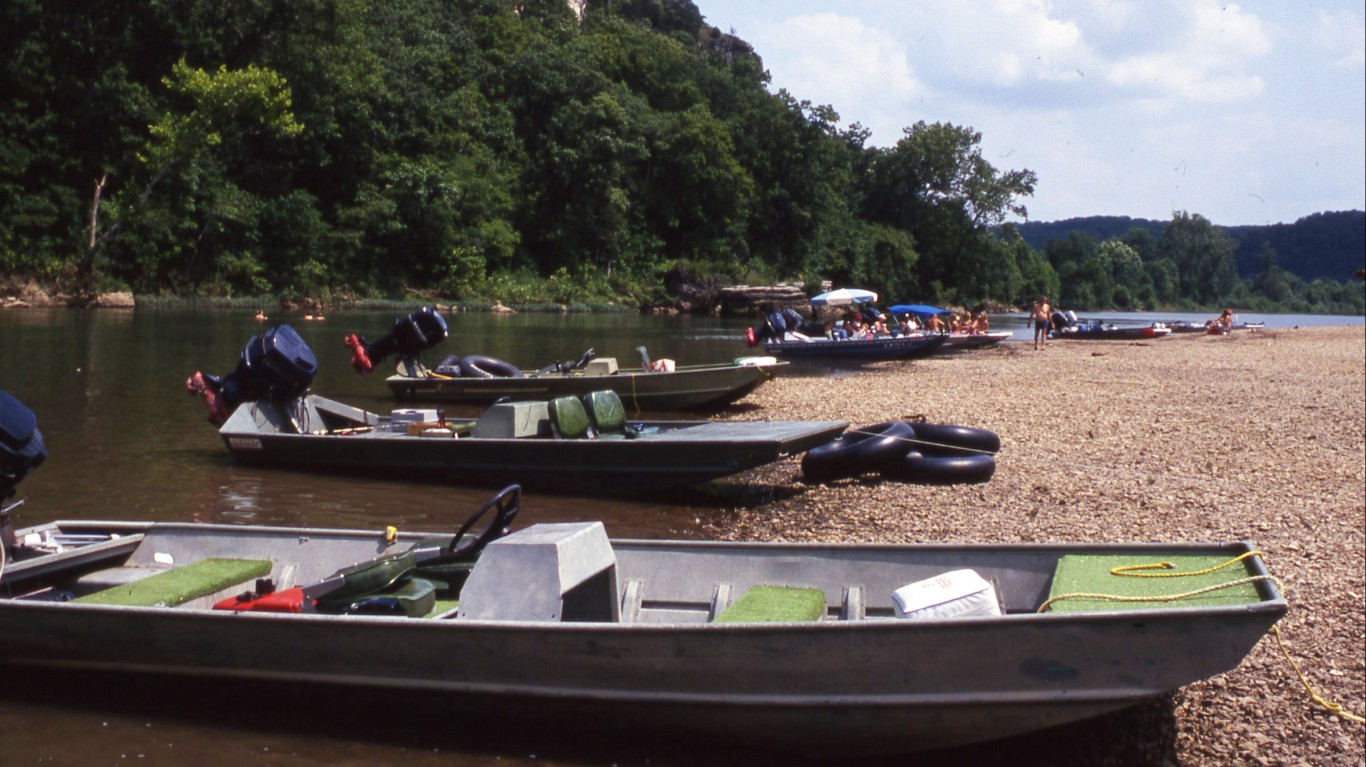
15. Gasconade River
> Region: Missouri
> Length: 250 miles
> Corridor temperature: 57.2 F
> Corridor annual precipitation: 44.9 inches
The Gasconade River arises in the Ozark Mountains and flows northeast for approximately 250 miles before emptying into the Missouri River. The average temperature along the Gasconade River corridor rose from 54.8 degrees Fahrenheit in 1967 to 57.2 degrees Fahrenheit in 2017, one of the largest spikes in average temperature of any large river.
The climate emergency is contributing to a rise in extreme weather events in the river corridor, with four of the five worst floods on record occurring in the last decade. Below average streamflow during dry seasons, and future declines in water levels, may also be impacting the corridor’s native fish and aquatic vertebrate species. The river is home to, among other species, the bleeding shiner, Ozark minnow, bullfrog, and river otter.
[in-text-ad]
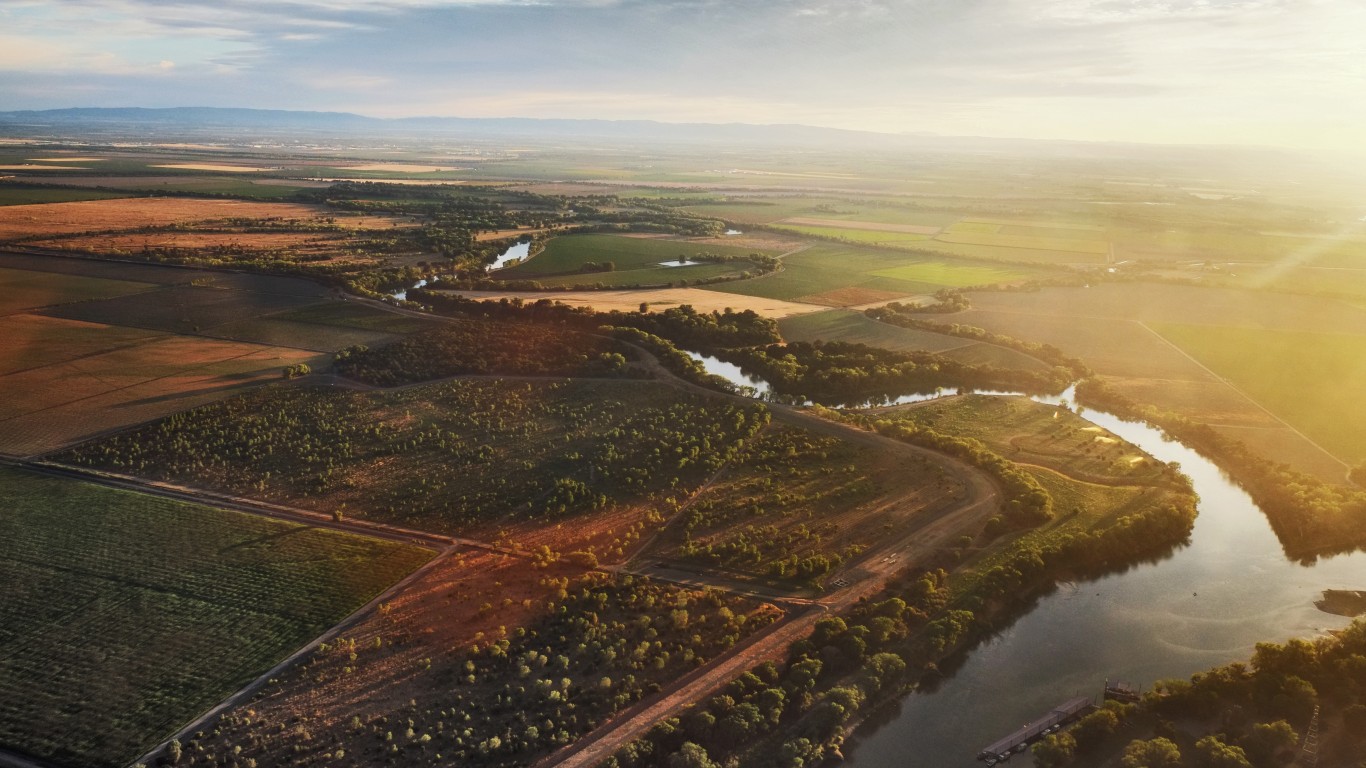
14. Sacramento River
> Region: California
> Length: 382 miles
> Corridor temperature: 62.5 F
> Corridor annual precipitation: 30.9 inches
The Sacramento River originates in the Klamath Mountains in the northern part of the state and flows south for 382 miles before forming a common delta with the San Joaquin River at San Francisco Bay. Like many bodies of water in California, the changes associated with the climate crisis, as well as recent water diversion projects, have taken their toll on the Sacramento River. From 1967 to 2017, the average annual temperature along the river corridor rose from 60.7 to 62.5 degrees Fahrenheit, one of the largest spikes of any major river.
According to a representative from the Sites Project Authority, a planning body pursuing the development of the Sites Reservoir Project in the Sacramento Valley, the Sacramento Valley is already experiencing snowmelt runoff earlier in the year than usual. Reduced streamflow in dry seasons is likely to significantly impact the area’s agriculture industry and the more than 50 endangered species that inhabit the river.
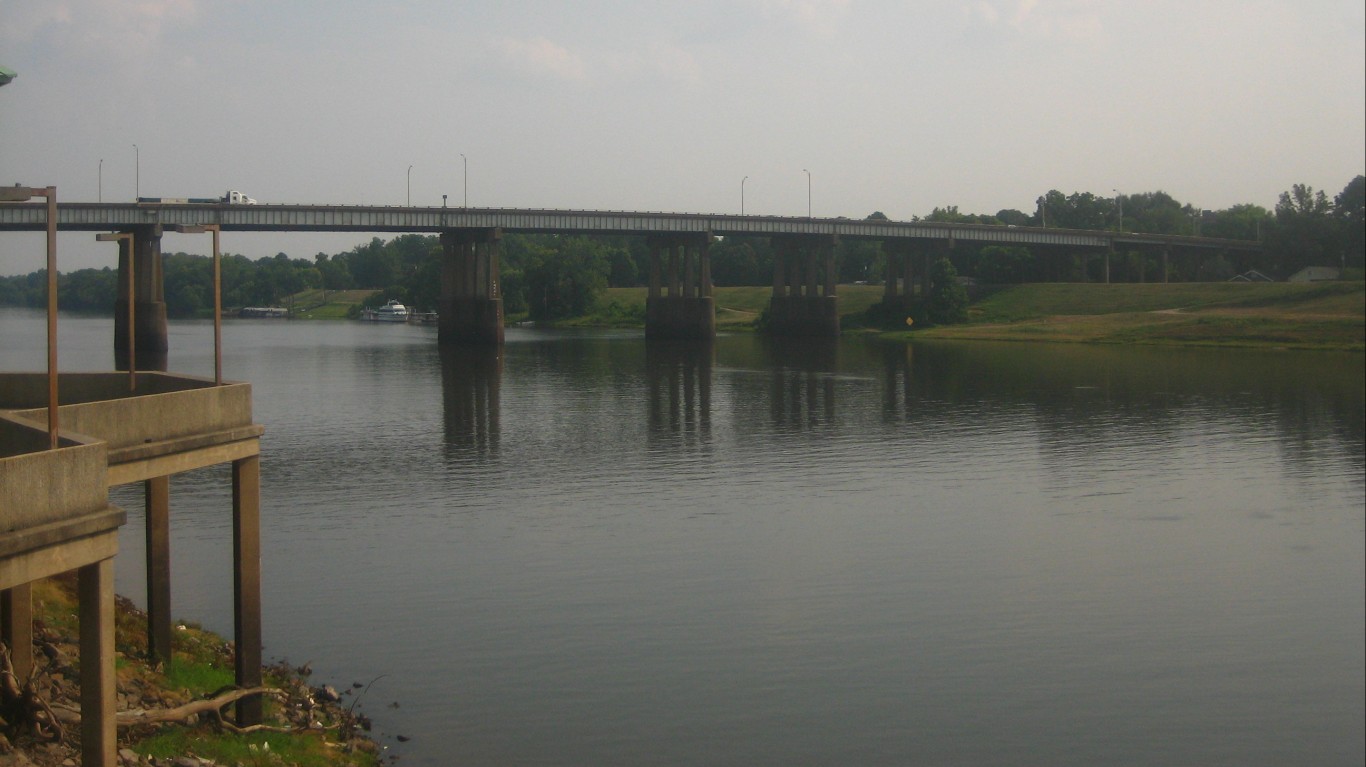
13. Ouachita River
> Region: Arkansas, Louisiana
> Length: 605 miles
> Corridor temperature: 65.1 F
> Corridor annual precipitation: 51.0 inches
The Ouachita River originates in the Ouachita Mountains of west-central Arkansas and flows southeast for approximately 605 miles before meeting the Red River in Louisiana. Used primarily for shipping, recreation, and as a municipal and industrial water source, the Ouachita River produces about $5.7 billion in economic activity annually and supports 21,000 full-time jobs, according to a November 2017 study from the University of Louisiana at Monroe.
A lack of funding for critical levee infrastructure, however, as well as the growing threats associated with the climate crisis, may lead to lower dry season streamflow in the near future and reduced economic growth. From 1967 to 2017, the average temperature of the Ouachita River corridor rose from 63.1 to 65.1 degrees Fahrenheit, one of the largest spikes of any major river. Low streamflow may also impact the river’s 12 endangered mussel and fish species.
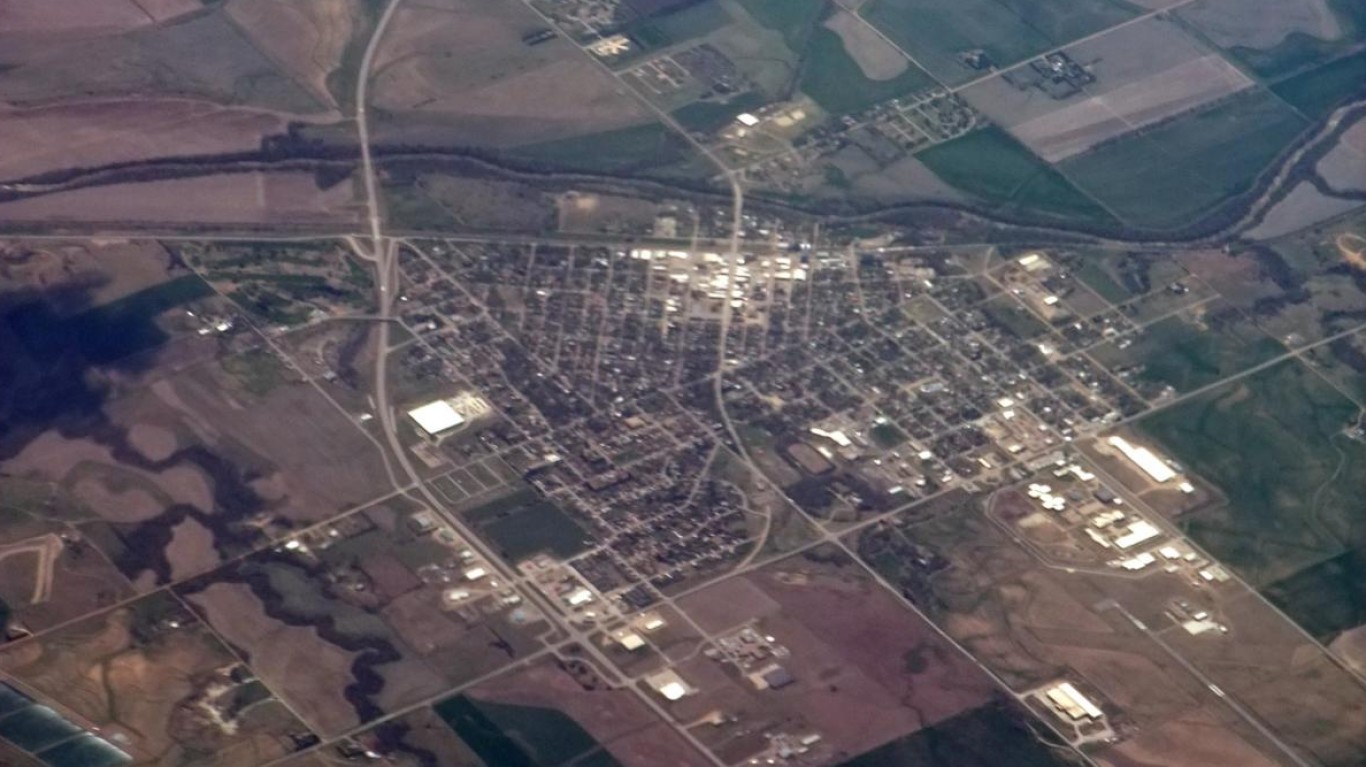
12. Smoky Hill River
> Region: Colorado, Kansas
> Length: 560 miles
> Corridor temperature: 56.0 F
> Corridor annual precipitation: 26.6 inches
The Smoky Hill River arises in the High Plains of eastern Colorado and flows east into Kansas for approximately 560 miles before emptying into the Kansas River. The Smoky Hill River flows through an area that historically has been subject to extended, multi-year droughts, and certain observation stations have reported low- or no-flow in recent years.
Due primarily to recent drought, parts of the Smoky Hill River registered record-low streamflow in the last 15 years. The average temperature of the Smoky Hill River corridor rose from 54.0 degrees in 1967 to 56.0 degrees in 2017, and annual average precipitation fell from 28.0 inches to 26.6 inches. Over the past year, 11.5% of the Smoky Hill River corridor was in severe drought, among the largest shares of any U.S. river longer than 500 miles.
[in-text-ad-2]
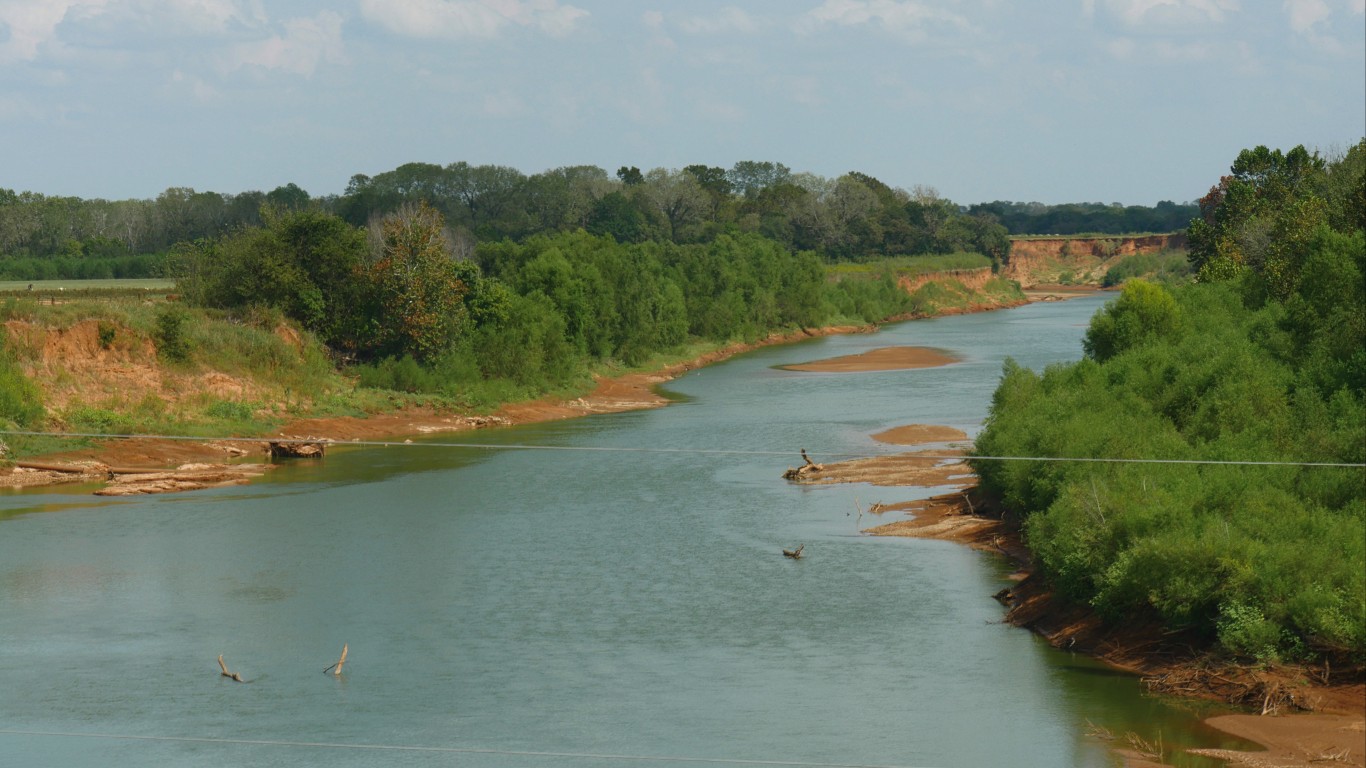
11. Washita River
> Region: Texas, Oklahoma
> Length: 626 miles
> Corridor temperature: 61.3 F
> Corridor annual precipitation: 32.7 inches
The Washita River originates in the Texas Panhandle and flows east through Oklahoma for approximately 626 miles before its confluence with the Red River. Like other tributaries of the Red River, the Washita is at risk of long-term flow reduction due in part to the accelerating effects of the climate crisis. Over the past year, 16.2% of the river corridor was in severe drought — conditions in which crop or pasture losses are likely and water shortages are common, according to the U.S. Drought Monitor. This was among the largest shares of any major river.
While the Washita River is largely used for recreation and agriculture, lower flow levels could affect major fish populations such as the gizzard shad, speckled chub, channel catfish, longear sunfish, and red shiner.
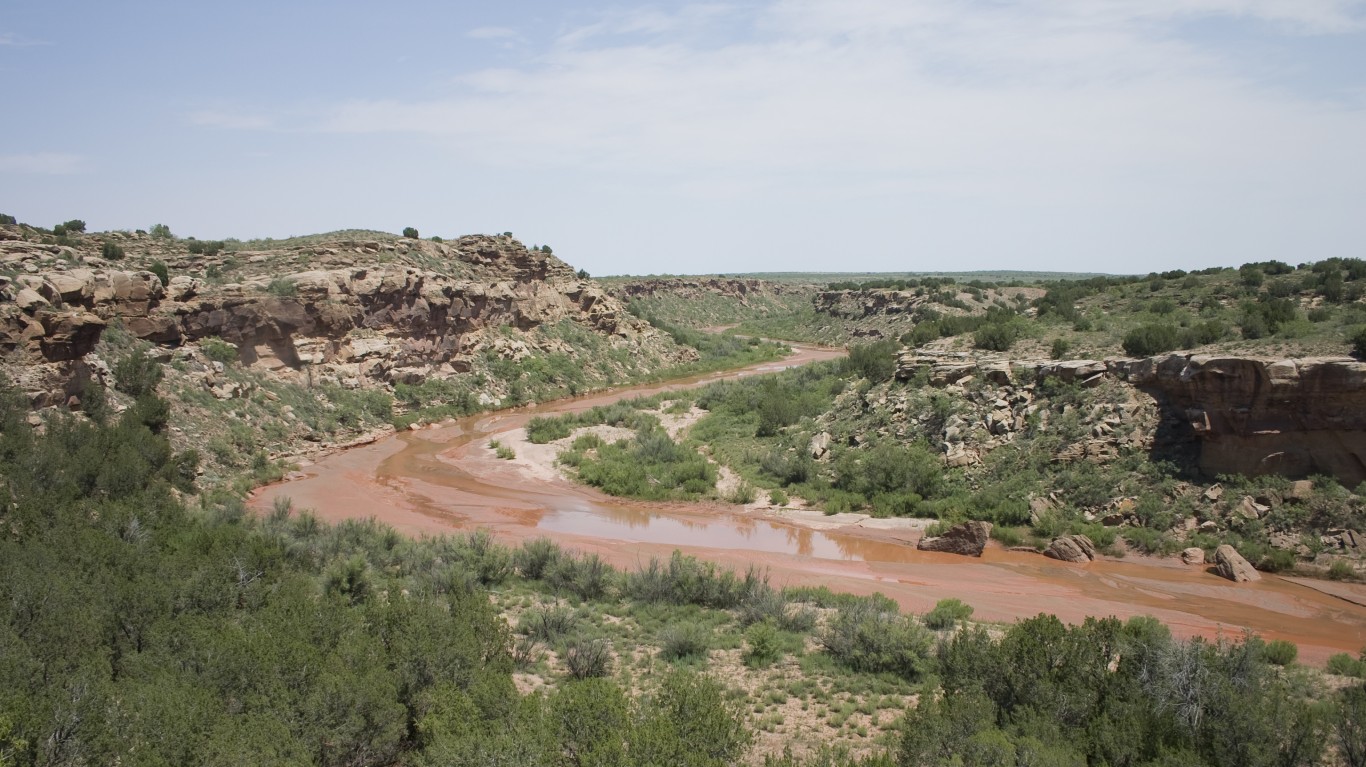
10. Red River
> Region: New Mexico, Texas, Louisiana
> Length: 1,290 miles
> Corridor temperature: 63.8 F
> Corridor annual precipitation: 49.8 inches
The Red River originates in eastern New Mexico and flows southeast through Texas and Louisiana for approximately 1,290 miles before meeting with the Atchafalaya River. Situated in some of the most drought-susceptible land in the United States, some parts of the Red River corridor spent several weeks in severe drought over the past year. The average annual temperature of the river corridor rose from 61.8 degrees in 1967 to 63.8 degrees in 2017, among the greatest increase of any major river.
Like many rivers at risk of water shortage, the Red River is the subject of several interstate water rights disputes. In one recent case, the U.S. Supreme Court decided that Texas did not have the right to obtain water from within Oklahoma state borders under the 1978 Red River Compact, which will likely increase demand for water along the Texas portion of the river.
[in-text-ad]
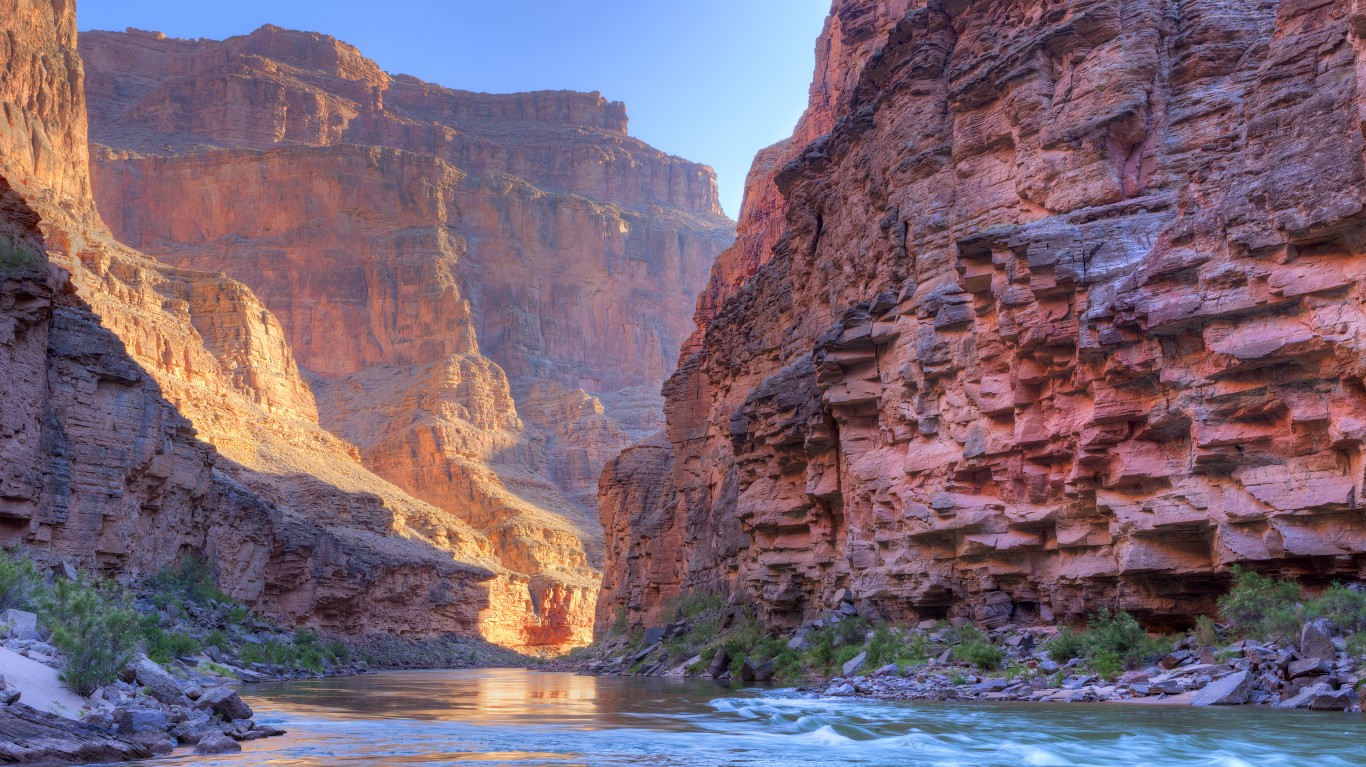
9. Colorado River
> Region: Wyoming, Colorado, Utah, New Mexico, Nevada, Arizona, California
> Length: 1,450 miles
> Corridor temperature: 67.5 F
> Corridor annual precipitation: 33.3 inches
The main stem of the Colorado River originates in the Rocky Mountains and flows southwest through Colorado, Utah, Arizona, Nevada, California, and Mexico for 1,450 miles before emptying into the Gulf of California.
Due to climate change-driven aridification, population growth, and overallocation, the Colorado is at risk of long-term water shortages causing flow reductions. The average temperature of the Colorado River corridor rose by approximately 1 degree over the last 50 years, and the population living in the counties surrounding the river grew by 10.9% from 2012 to 2017 — nearly three times the comparable national growth rate.
Overallocation problems date back to the 1922 Colorado River Water Compact, which — in light of recent analysis — was based on overestimated flow levels and resulted in over-appropriation of the river’s resources. According to researchers from Colorado Water Institute of Colorado State University, the flow of the Colorado River flow could fall by 20% by 2050 and 35% by 2100 if current levels of greenhouse gas emissions persist and climate change continues at its current rate.
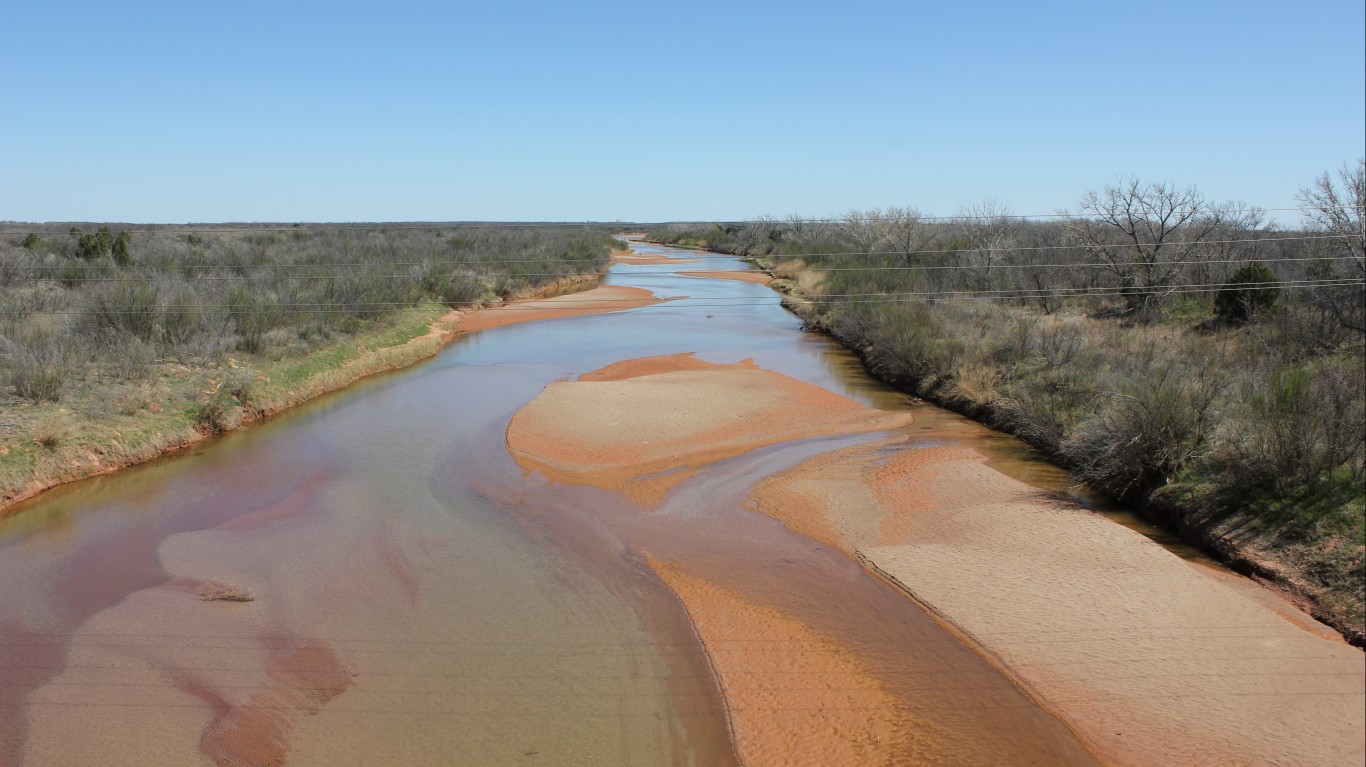
8. Brazos River
> Region: New Mexico, Texas
> Length: 1,280 miles
> Corridor temperature: 68.3 F
> Corridor annual precipitation: 44.1 inches
The longest river in Texas and 11th longest in the United States, the Brazos River flows 1,280 miles through eastern New Mexico and Texas into the Gulf of Mexico. Recent drought and population growth have raised political tensions over water allocation in the area. Some 8.3% of the river corridor was in severe drought over the past 53 weeks, and the number of residents in the counties surrounding the river rose 11.5% from 2012 to 2017, three times the national rate at the time.
In 2015, the Texas Commission on Environmental Quality appointed a watermaster to help monitor and resolve water rights disputes in the lower half of the Brazos basin, the fourth program of its kind in the state. As water becomes scarcer and water rights more contested, regulatory agencies like the TCEQ’s watermaster program are likely to become more common in drought-susceptible areas.
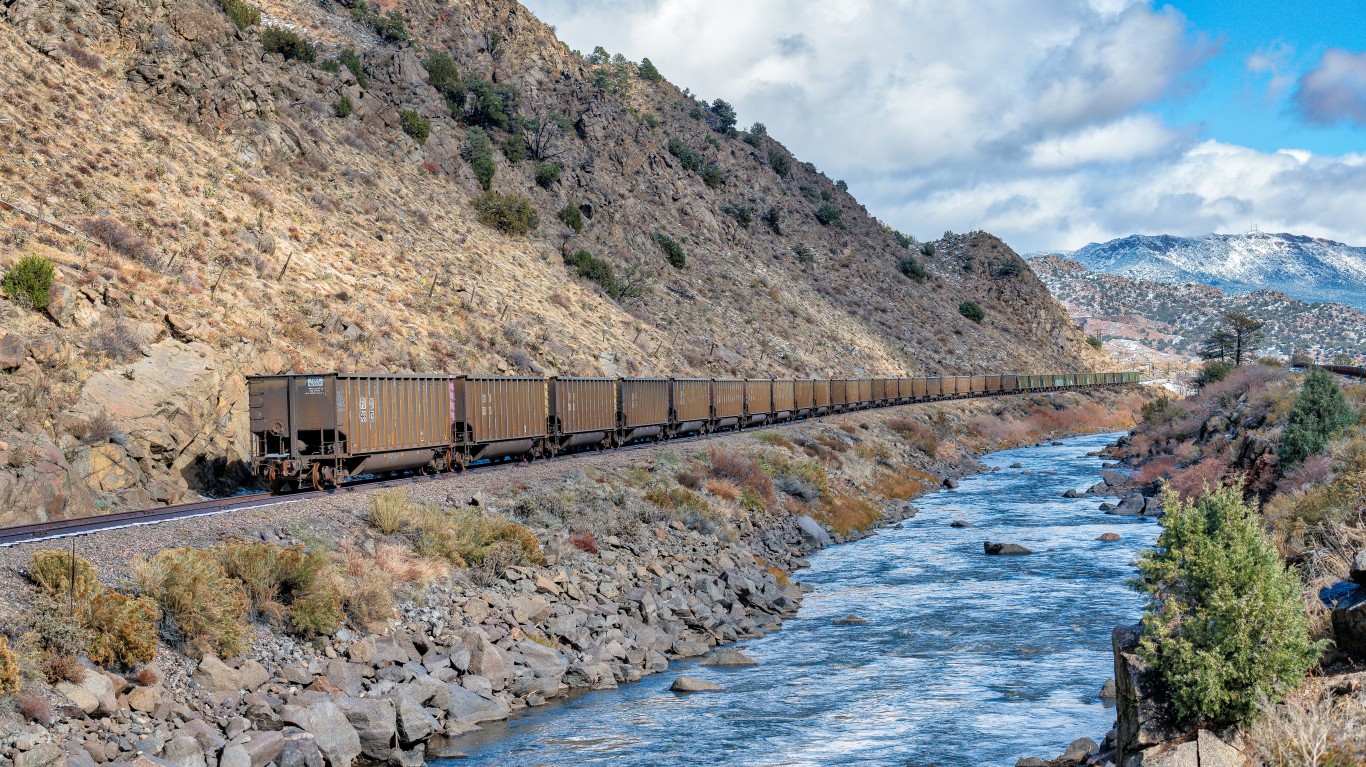
7. Arkansas River
> Region: Colorado, Kansas, Oklahoma, Arkansas
> Length: 1,460 miles
> Corridor temperature: 55.9 F
> Corridor annual precipitation: 29.5 inches
Arising in the Sawatch Range of the Rocky Mountains and flowing through Colorado, Kansas, Oklahoma, and Arkansas for 1,460 miles before its confluence with the Mississippi, the Arkansas River has played a key historic role in America’s westward development and continues to be an essential part of the area’s agriculture and tourism industries.
Like many bodies of water in the Mississippi River basin, the Arkansas River is highly susceptible to drought and increasingly, the effects of the climate emergency. More than one-fifth of the river corridor is in severe drought, and the average temperature of the corridor rose from 54.4 degrees in 1967 to 55.9 degrees in 2017. According to researchers from Colorado Water Institute of Colorado State University, river flow could fall by 20% by 2050 and 35% by 2100 if current drought conditions and higher temperatures due to greenhouse gas emissions persist.
[in-text-ad-2]
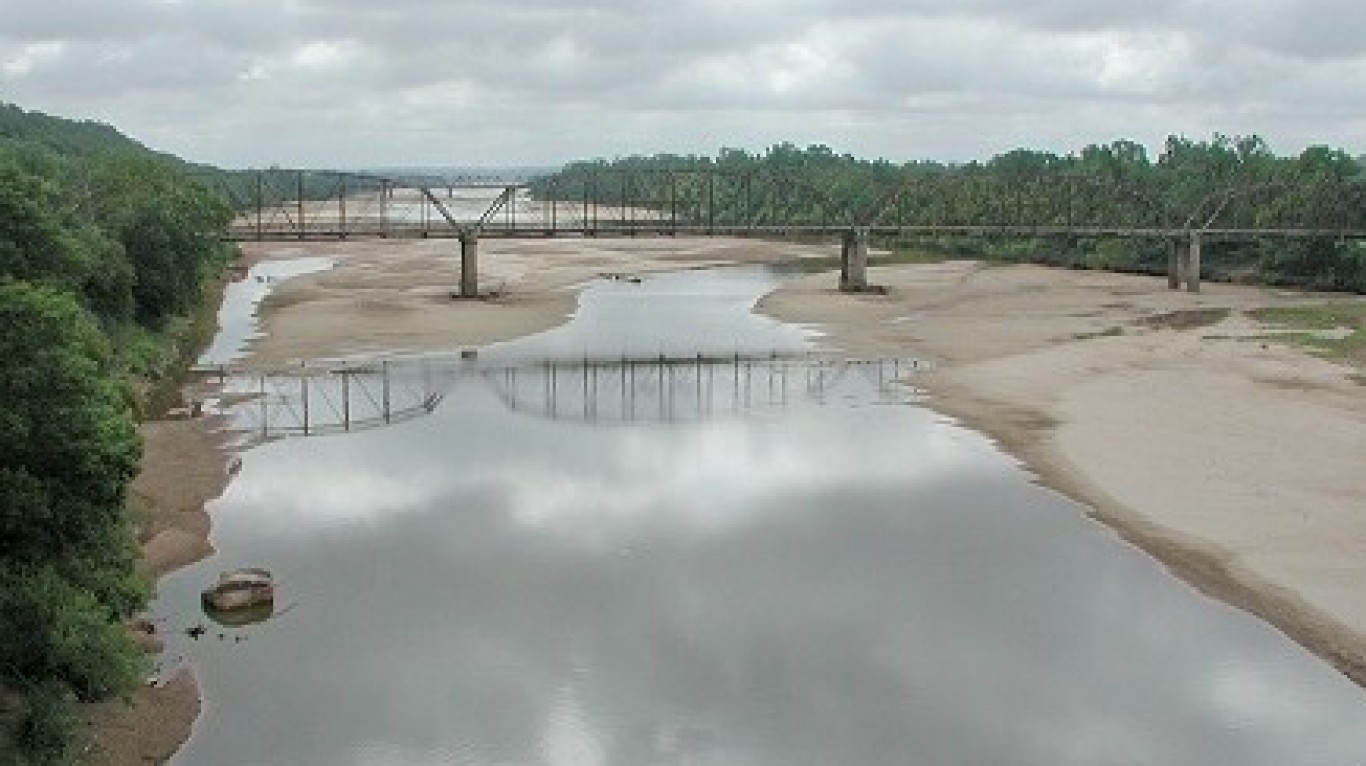
6. Canadian River
> Region: New Mexico, Texas, Oklahoma
> Length: 906 miles
> Corridor temperature: 58.5 F
> Corridor annual precipitation: 30.8 inches
The longest tributary of the Arkansas River, the Canadian River originates in the Sangre de Cristo Mountains in northeastern New Mexico and flows eastward for approximately 906 miles through the Texas Panhandle and Oklahoma before meeting the Arkansas at the western base of the Boston Mountains. The counties in the Canadian River corridor were in severe drought for 16.4 weeks over the past year, among the most of any large river.
The lack of rainfall in the river corridor is made worse by the presence of salt cedar, an invasive shrub and small tree species that consumes large amounts of water and whose salty leaves prevent growth of nearby plants. Salt cedar first spread to western river banks in the late 19th century, and over the past 150 years has narrowed the Canadian River and negatively impacted local fish populations such as the Arkansas River shiner.
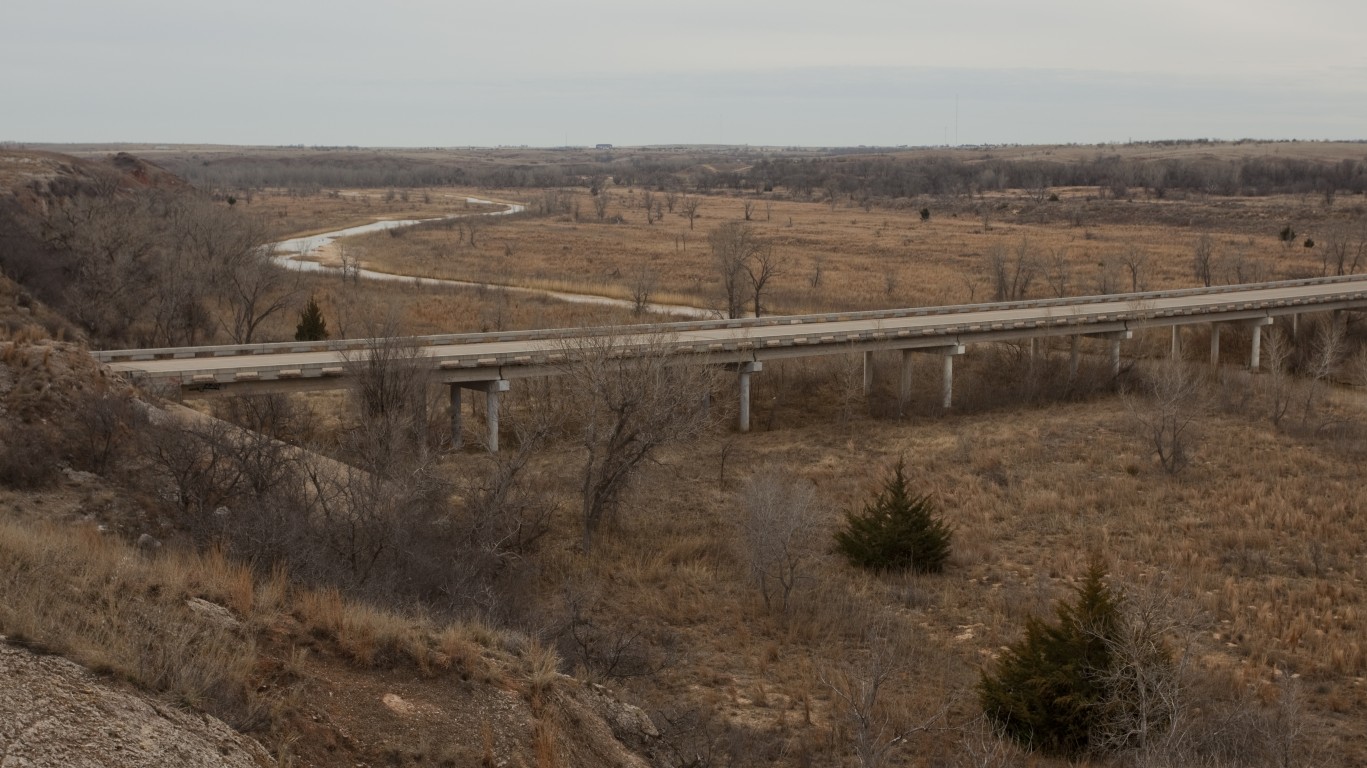
5. North Fork Red River
> Region: Texas, Oklahoma
> Length: 271 miles
> Corridor temperature: 61.9 F
> Corridor annual precipitation: 29.8 inches
The North Fork Red River originates in the Texas Panhandle and flows eastward through the state for approximately 271 miles before it empties into the Red River along the Texas-Oklahoma border. Like many bodies of water in the southern portion of the Mississippi River basin, North Fork Red River is situated in drought-susceptible land, made more vulnerable to drought as temperatures continue to rise due to climate change. Over the past year, 30.3% of the North Fork Red River corridor was classified as being in severe drought — conditions in which crop or pasture losses are likely and water shortages are common, according to the U.S. Drought Monitor — among the most of any major river.
[in-text-ad]
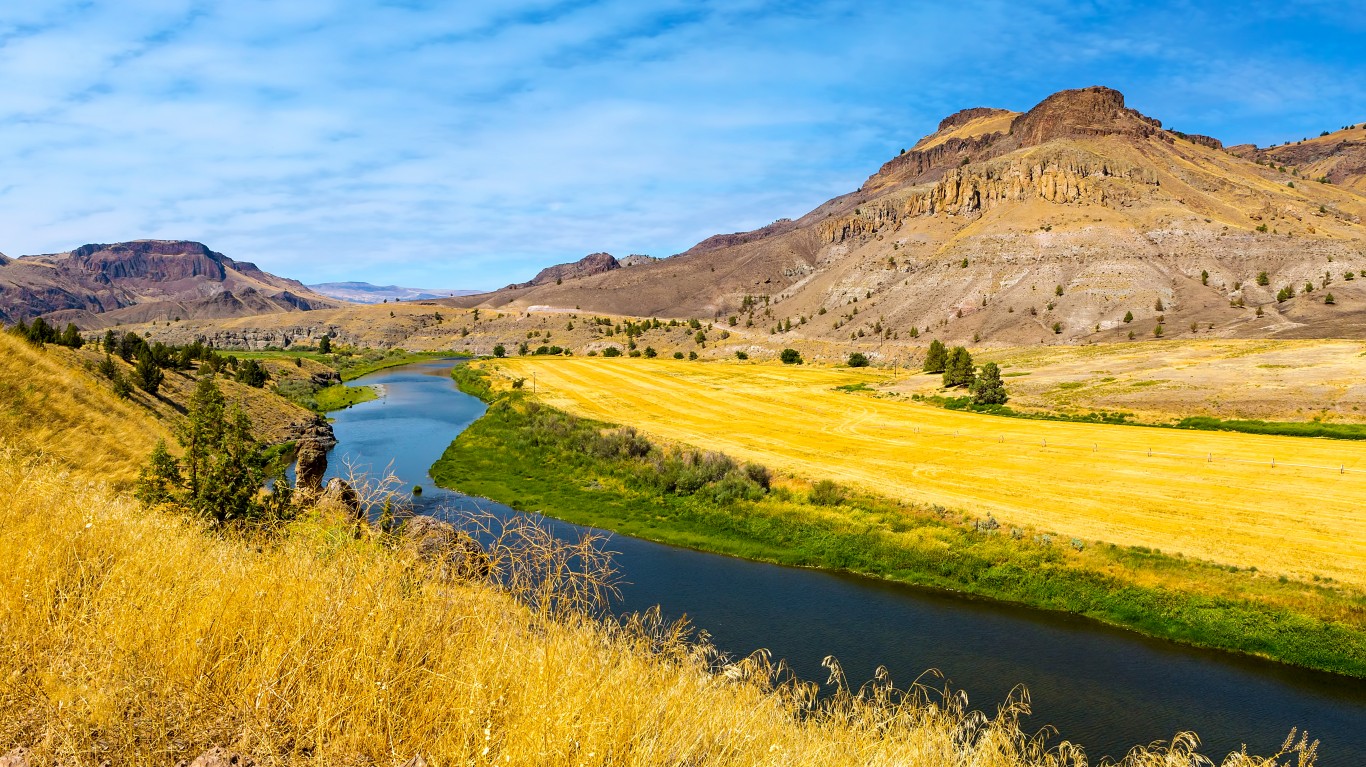
4. John Day River
> Region: Oregon
> Length: 284 miles
> Corridor temperature: 48.6 F
> Corridor annual precipitation: 13.0 inches
The second longest undammed river in the contiguous United States, the John Day River originates in the Blue Mountains of Central Oregon and flows approximately 284 miles before it empties into the Columbia River. Because there are no dams along the river, the flow fluctuates considerably throughout the year and at times becomes very low, which can cause serious disruptions to move patterns of the local fish population. In recent summers, for example, hundreds of Chinook salmon — whose populations in tributaries of the Columbia River are federally listed as endangered — died due to high temperatures and low stream flow. Other endangered fish species that may be affected by the river’s fluctuating flow and drought conditions include bull trout and summer steelhead. Over the past year, 51.1% of the John Day River corridor was in severe drought, among the most of any major river.
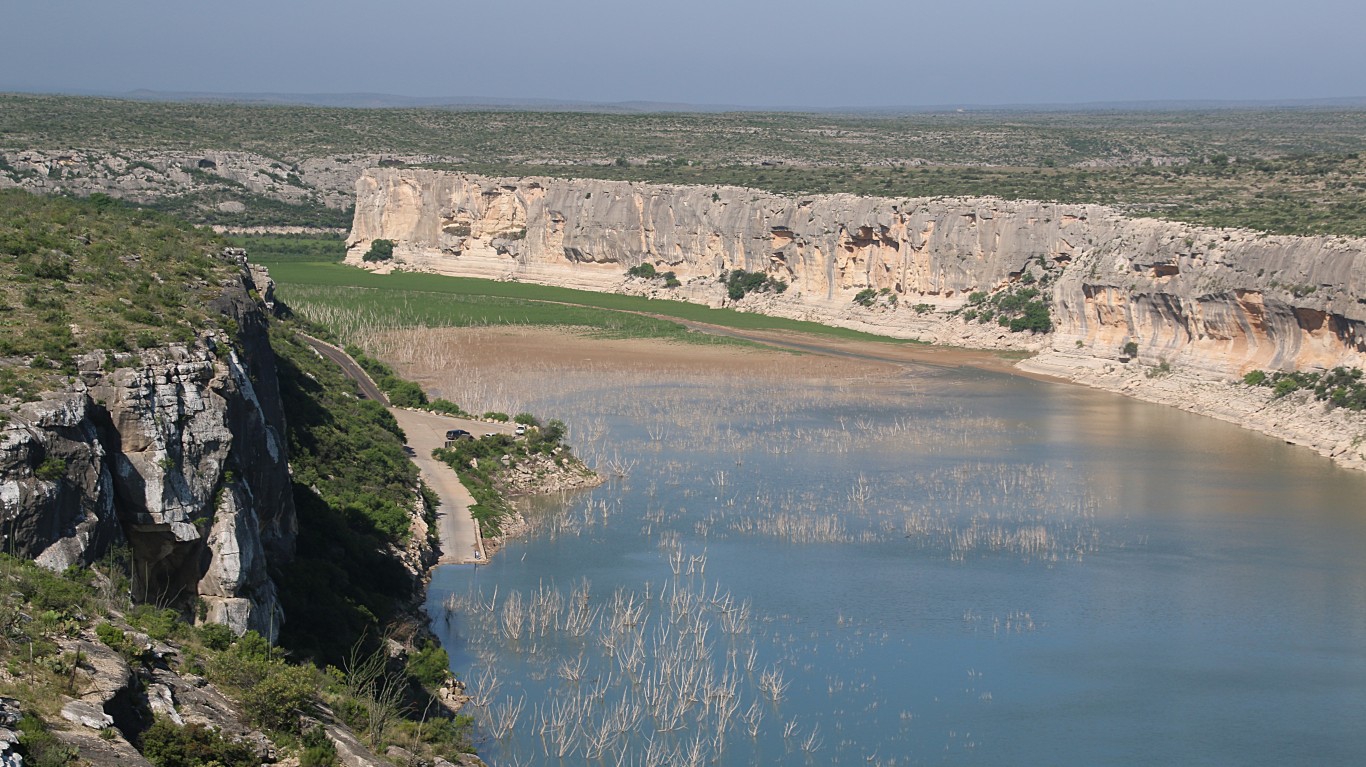
3. Pecos River
> Region: New Mexico, Texas
> Length: 926 miles
> Corridor temperature: 64.1 F
> Corridor annual precipitation: 17.4 inches
The Pecos River originates in the Sangre de Cristo Mountains in north-central New Mexico and flows through the eastern part of the state into Texas for approximately 930 miles before it empties into the Rio Grande. Situated in some of the most drought-prone land in the United States, more than one-fifth of the Pecos River corridor was classified as being in severe drought over the past year, and the temperature along the corridor rose from an average of 62.2 to 64.1 degrees from 1967 to 2017.
According to representatives from the New Mexico Department of Game & Fish, years of drought and declining stream flow are having an adverse effect on the river’s fish population.
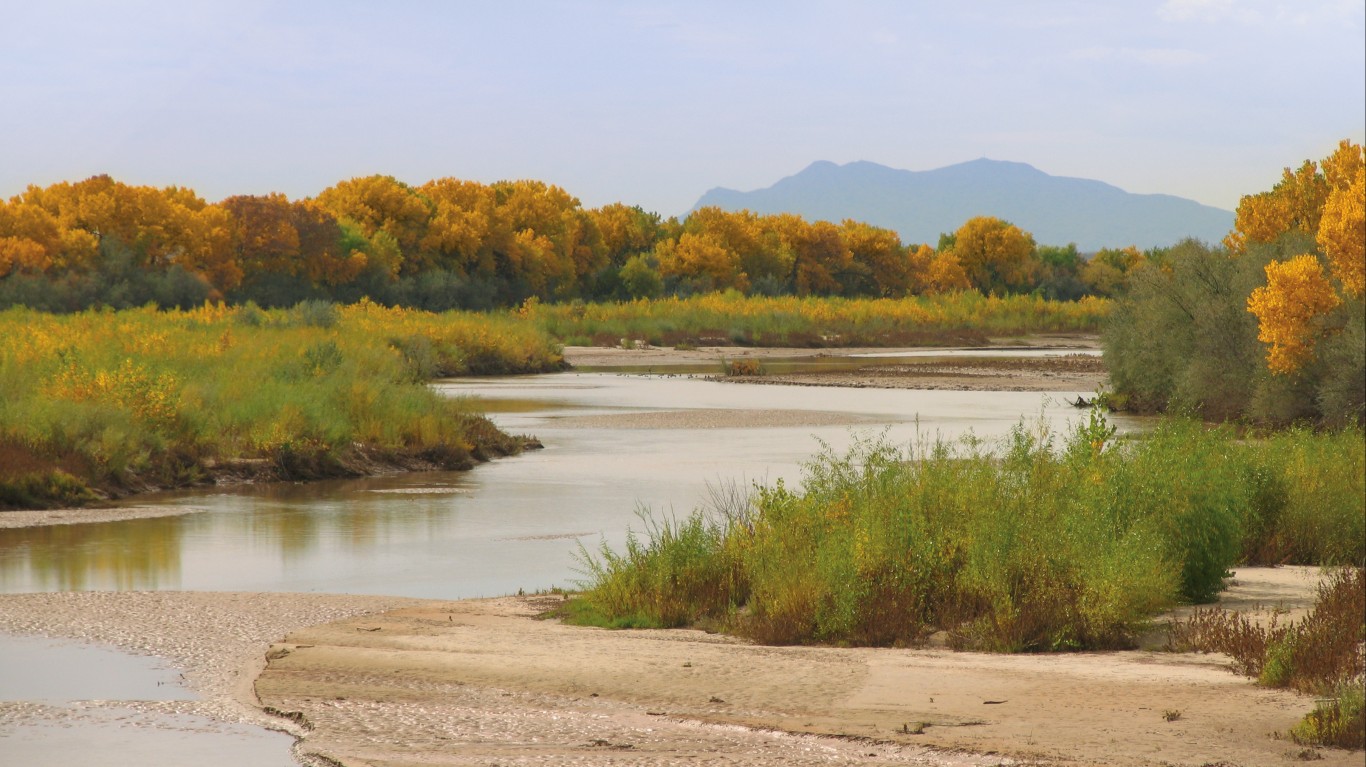
2. Rio Grande
> Region: Colorado, New Mexico, Texas, Mexico
> Length: 1,900 miles
> Corridor temperature: 66.4 F
> Corridor annual precipitation: 16.7 inches
Running from the Colorado Rockies to the Gulf of Mexico, the Rio Grande is situated in some of most drought-susceptible land in the United States. From 1967 to 2017, the average temperature along the Rio Grande corridor rose from 63.4 to 66.4 degrees, and annual precipitation fell from 19.1 to 16.7 inches — each some of the largest changes of any river corridor. Over the past year, the counties that the Rio Grande flows through spent 16.1 weeks in severe drought, among the most of any major river.
The once-mighty flow of the Rio Grande is being staunched by heavy demand and overallocation. Water rights to the Rio Grande are shared by the United States and Mexico under the provisions of the Treaty of 1944, which allows both countries to build and operate dams on the river’s main channel. As the population of the Rio Grande basin swells in both countries, more of its water is withdrawn for agricultural and municipal use, reducing the river’s flow and — in some years — preventing it from reaching the sea.
[in-text-ad-2]
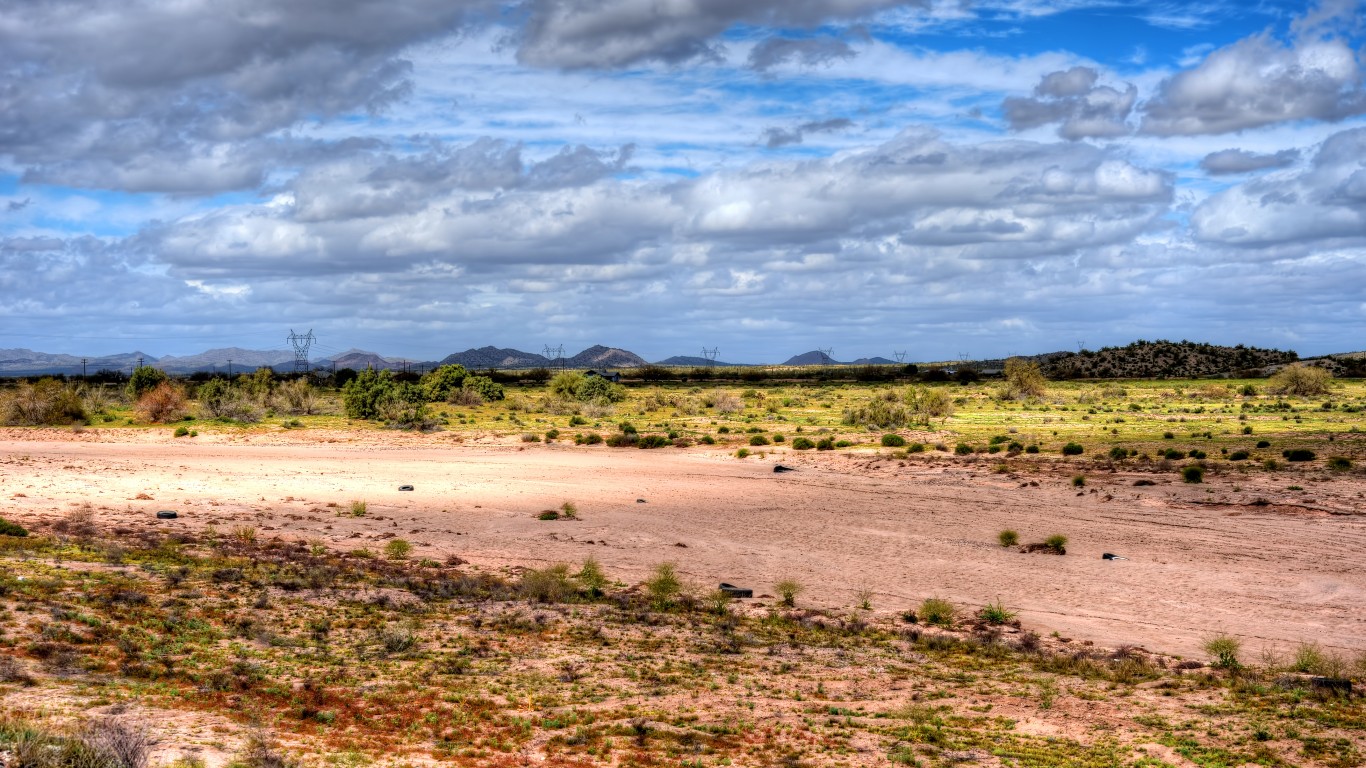
1. Gila River
> Region: New Mexico, Arizona
> Length: 630 miles
> Corridor temperature: 69.3 F
> Corridor annual precipitation: 7.7 inches
The last major free-flowing river in New Mexico, the Gila River is home to several populations of endangered and threatened bird species and is currently under threat of drying up due to the accelerating impacts of climate change, and overallocation. Approximately 40% of the Gila River corridor was in severe drought over the past year, and the average annual temperature along the corridor rose from 65.5 degrees in 1967 to 69.3 degrees in 2017 — one of the greatest increases of any river corridor over the period.
Precipitation has also declined substantially, falling from 12.2 inches in 1967 to 7.7 inches in 2017. Climate change, as well as heavy demand and water mismanagement, are some of the reasons the Gila River currently ranks No. 1 on national advocacy group American Rivers’ 2019 America’s Most Endangered Rivers report. According to the report, a proposed diversion project on pace to be approved at the end of 2019 will actually exacerbate the Gila River’s weakening flow, which has been dwindling from declining snow pack.
Detailed Findings
Many of the counties surrounding America’s largest rivers are in places where the weather is getting worse because of climate change and many were in severe drought for a third of the past year. Severe drought is classified as conditions in which crop or pasture losses are likely and water shortages are common, and municipalities may impose water use restrictions, according to the U.S. Drought Monitor. In some river corridors, more than 50% of the land was classified as being in severe drought over the past 53 weeks.
The rising temperatures of many American river corridors can also be traced to the climate crisis. The average annual temperature in the counties surrounding the 15 rivers on this list rose by 1.6 degrees on average from 1967 to 2017, with the Gila River and Rio Grande corridors registering the largest increases.
Increased surface temperatures can cause both drought-inducing heat waves as well as extreme storms when combined with excess moisture. Some of the worst floods in American history occurred around the Mississippi and Missouri Rivers, which may be subject to more natural disasters as the climate crisis continues to accelerate.
One of the biggest threats to America’s rivers is the overallocation of water resources. Many of America’s largest rivers run along state borders, with water rights divided among multiple state and local authorities in complicated, decades-old agreements. Some water transfer agreements — the 1922 Colorado River Water Compact, for example — are based on overestimations of streamflow levels and ensure that rivers will be perpetually overdrawn.
As water resources become more sparse, political tension and litigation over water rights may become more intense. In 2015, the Texas Commission on Environmental Quality appointed a watermaster to help monitor and resolve water rights disputes in the lower half of the Brazos basin, the fourth program of its kind in the state.
Methodology
To determine the U.S. rivers running dry, 24/7 Wall St. constructed an index based on the weeks spent in severe drought, the percentage of land classified as being in severe drought, the change in annual temperature and precipitation of major U.S. river corridors.
The weeks in which a river corridor had more than 0% of land categorized as D2 severe drought from May 8, 2018 to May 14, 2019 came from the U.S. Drought Monitor and was included in the index at full weight. The average percentage of land categorized as D2 severe drought from May 8, 2018 to May 14, 2019 also came from the U.S. Drought Monitor and was included in the index at full weight. Data on the change in average annual temperature in degrees Fahrenheit from 1967 to 2017 came from the Parameter-elevation Regressions on Independent Slopes Model (PRISM) Climate Group of the U.S. Department of Agriculture and was included in the index at full weight. Data on the change in annual precipitation from 1967 to 2017 also came from the PRISM Climate Group and was included in the index at one-quarter weight. All data is at the county level and was aggregated to river corridors based on the proportion of a river’s length situated within a given county.
River lengths and geography were based on a shapefile of U.S. rivers and streams from GIS software company Esri’s ArcGIS REST services directory. County boundaries were based on U.S. Census Bureau definitions and are current as of 2018. Population data are five-year estimates from the U.S. Census Bureau’s American Community Survey. Only rivers greater than or equal to 250 miles in length were considered.
Thank you for reading! Have some feedback for us?
Contact the 24/7 Wall St. editorial team.
 24/7 Wall St.
24/7 Wall St.


